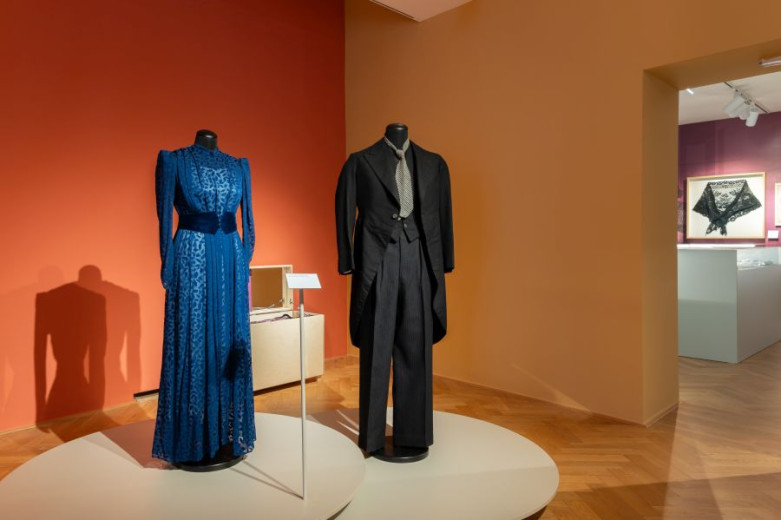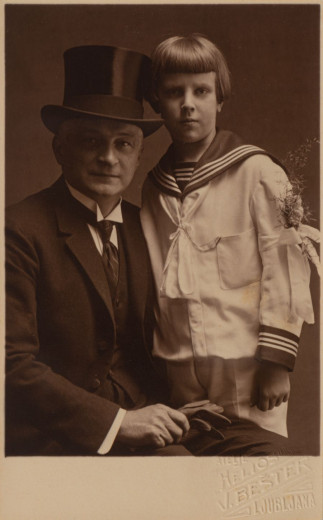Date: 7. October 2024
Time to read: 3 min
The development of fashion has always occurred within a social, political, and economic framework. Therefore, clothing style is something that reveals a great deal about a certain time period, people, their relationships, and civilization.
We dress as part of a culture, an era, as well as based on personal beliefs and knowledge. Fashion is an important part of our lives. On one hand, it represents us; on the other, it hides our emotions, making us feel more beautiful and confident.
-
 At the opening of the exhibition "From Corset to Jacket" in the City Museum of Ljubljana (11.4.2024-23.2.2025). Photo: Blaž Gutman/MGML
At the opening of the exhibition "From Corset to Jacket" in the City Museum of Ljubljana (11.4.2024-23.2.2025). Photo: Blaž Gutman/MGML
-
 For the youngest, a printed children's guide will make the exhibition more accessible, and interactive chests will enhance the walkthrough; family and educational workshops have also been prepared. Photo: Blaž Gutman/MGML
For the youngest, a printed children's guide will make the exhibition more accessible, and interactive chests will enhance the walkthrough; family and educational workshops have also been prepared. Photo: Blaž Gutman/MGML
From Haute Couture to Prêt-à-Porter
When talking about haute couture, its origins undoubtedly date back to the 19th century. At the same time, this fashion already represents creative fashion. Haute couture emphasizes tailors and stylists, as garments are custom-made from start to finish. After 1960, the era of haute couture came to an end, and the period of prêt-à-porter emerged, characterized by more practical and simpler garments that became accessible to a wider range of customers.
To understand the clothing culture of Ljubljana's residents from the mid-19th century to the mid-20th century, it is essential to know some key facts about Ljubljana during that period.
Significant events that shaped the city include the arrival of the first train from Vienna in 1849, with the railway connection to Trieste completed eight years later. In 1895, Ljubljana experienced a devastating earthquake, leading to the construction of new streets and buildings. During this period, the mayor of Ljubljana was Ivan Hribar, who revitalized the city and made it modern. He renovated the infrastructure, improved the sewage system, established several new schools, and promoted national awareness.
Clothing as a Carrier of Memory
Significant personal events and mlestones in a person's such as baptism, communion, confirmation ceremonies, wedding and funeral or mourning ceremonies also call for a festive outfit and express the formal nature of the moment.The bride's long white wedding dress became fashionable from the mid-19th century and continued to be popular between the two world wars. Later, white lost its significance, and wedding dresses appeared in other colors and shorter styles. Among the bourgeoisie, the groom’s wedding attire typically consisted of a jacket, dark or gray striped trousers, a vest, a white shirt, a tie or bow tie, light gloves, and a black top hat.
In the clothing culture of Ljubljana’s residents, in addition to wedding attire, it is also interesting to highlight customs around baptisms and funerals.
After a person's death, widows and close relatives traditionally wore mouring clothes for at least some time, usually for at least six months. At funerals, women were veiled to the waist, and later they wore a veil or "šlajer" (mourning veil). In contrast to weddings or funerals, baptismal garments were always white. The white color symbolized the pure soul of the child. Children were wrapped in special white linen bags, decorated with lace, ribbons, and similar adornments. An interesting custom, now no longer in practice, was that people did not wear slippers at home but instead wore shoes.
-
 Bridal dresses are becoming shorter, and some are no longer made of lace. Photo: Blaž Gutman/MGML
Bridal dresses are becoming shorter, and some are no longer made of lace. Photo: Blaž Gutman/MGML
-
 Until the age of three, children wore a shirt dress; clothing was similar for girls and boys, with differences in fastening, color, and fabric. By the end of the 19th century, sailor suits appeared for both sexes. Photo: Blaž Gutman/MGML
Until the age of three, children wore a shirt dress; clothing was similar for girls and boys, with differences in fastening, color, and fabric. By the end of the 19th century, sailor suits appeared for both sexes. Photo: Blaž Gutman/MGML
-
 Before the start of the dance season, recognized seamstresses were very busy, and fashion fabric stores offered prestigious materials such as brocade, taffeta, various silks, velvet, georgette, and lace. Decorative accessories were created by makers of silk flowers. Photo: Blaž Gutman/MGML
Before the start of the dance season, recognized seamstresses were very busy, and fashion fabric stores offered prestigious materials such as brocade, taffeta, various silks, velvet, georgette, and lace. Decorative accessories were created by makers of silk flowers. Photo: Blaž Gutman/MGML
Elegant underwear
From the mid-19th century onward, women in Ljubljana wore a variety of undergarments, including petticoats, drawers, day and night shirts, bodices, bras, corsets, chemises, stockings, and suspender belts. Underwear was e also part of a bride's dowry, the wealth she brought into marriage.
The Romantic era introduced long, high corsets that extended down to and beyond the hips, pushing the bust upwards. Around the mid-19th century, the crinoline appeared. At the beginning of the 20th century, long and narrow corsets became dominant.
These corsets were flat at the front, causing women to push their hips back and their chests forward, creating an unnatural S-shape, hence the name "S-corset." Corsets were heavily decorated with ruffles.
By around 1930, fashion favored a less feminine silhouette, and bras were designed to minimize the appearance of the breasts. Although corsets still existed to maintain a slim figure, belts began to replace them. These belts could be wide, flattening the stomach, or narrower versions, called "corsettes," used mainly to hold up stockings.
In the following period, strapless bras became fashionable for the first time, and corsets became elastic. Before and after World War II, undergarments became increasingly simple. However, the hourglass figure soon emerged, highlighting a narrow waist and full bust, often achieved with the help of corsets.
Social Events
In Slovenia, as in the rest of Europe, dancing followed local traditions and current dance trends. These trends arrived from the Austrian-German regions with a few years’ delay. The 19th century was marked by the waltz and Viennese dance music. In bourgeois settings, including in Ljubljana, dancing shifted to spacious ballrooms by the turn of the 20th century. This was the era of mass dancing, with polka and waltz dominating, along with various forms of the quadrille, can-can, mazurka, and gallop. Every dance event typically opened with the polonaise. At the beginning of the 20th century, the tango also became popular. New dances spread mainly through dance teachers who followed European dance trends.
Fashion adapted to musical trends as well. The waltz era, for example, was also the era of corsets and stays. However, by the early 20th century, women were already being encouraged to abandon corsets, though dance gloves remained a mandatory accessory.
In Ljubljana, wealthier families hosted "hausballs," informal dance parties where friends were invited orally, unless it was a more elegant dance for which formal invitations were sent.
Hausballs were fashionable after World War I, particularly in the 1930s. These dances were exclusive, meant for specially invited members of the bourgeoisie. Notable events included the elite bankers' ball, the elite merchants' ball, the elite medical ball, and the elite academic ball. Some were also organized in the Kazina or Union hall, Tabor, and Narodni dom. These events demanded elegant attire: women wore silk dresses, and men donned elegant black suits. Women from Ljubljana's bourgeoisie often accessorized with fur.
Residents of Ljubljana generally avoided extravagant cuts, and instead emphasised their elegance with simple lines. The finishing touch came in the form of eye-catching fashion accessory.
In the second half of the 19th century, there were far more milliners than hatters in Ljubljana, indicating that women's hats were in high demand. Women often traveled abroad, especially to Trieste, to purchase fabrics and followed current fashion trends. It was customary for women to keep their hats on when visiting someone’s home. In the mid-19th century, Ljubljana's bourgeoisie was largely inspired by Biedermeier fashion (long skirts, corsets). Men wore frock coats or long waist-fitted coats.
-
 Dances were one of the few opportunities for young people to meet even in the mid-20th century. The attention paid to the choice of dress was appropriate. In the photo: Dance dress for the press ball from 1956. Photo: Blaž Gutman/MGML
Dances were one of the few opportunities for young people to meet even in the mid-20th century. The attention paid to the choice of dress was appropriate. In the photo: Dance dress for the press ball from 1956. Photo: Blaž Gutman/MGML
-
 A dress for the Elite Ball in the Grand Hotel Union ballroom. Photo: Blaž Gutman/MGML
A dress for the Elite Ball in the Grand Hotel Union ballroom. Photo: Blaž Gutman/MGML
-
 A dancing couple at the Press Ball in the Grand Hotel Union ballroom in Ljubljana, 1956. Photo: MGML archive
A dancing couple at the Press Ball in the Grand Hotel Union ballroom in Ljubljana, 1956. Photo: MGML archive
Fashion stories of noble people
The selection in City Museum of Ljubljana includes also some notable figures from the worlds of: literature, visual arts, theatre and film, architecture and design,…such as Lily Novy, Mila Kačič, Ivan Cankar, etc.The eye catching for sure is Lily Novy, one of the the best Slovenian poets and translators of poetry in history, her umbrellas are interesting, featuring dog heads on the handles. And also, the sleeping cap that styled the hair of architect Jože Plečnik.
Sustainable Fashion
In centuries past, people's attitude to dressing was different that is today. Dressing held a value, meaning the old clothes were never thrown away.
One could say that "clothes grew with the person." Second-hand clothes were not only passed among family members, but they could also be purchased in numerous antique shops.
Although today's fashion is shifting towards sustainability, it is a fact that in the past, all women knew how to sew and patch. Clothing was used for as long as possible. Thus, the very way of life, of which fashion was a part, was sustainable and practical.
Today's concept of sustainable fashion has much in common with past practices. Ecological and ethical aspects are taken into account, and recycling clothes swapping, making new pieces from discard or unused but good quality fabric are also included.













